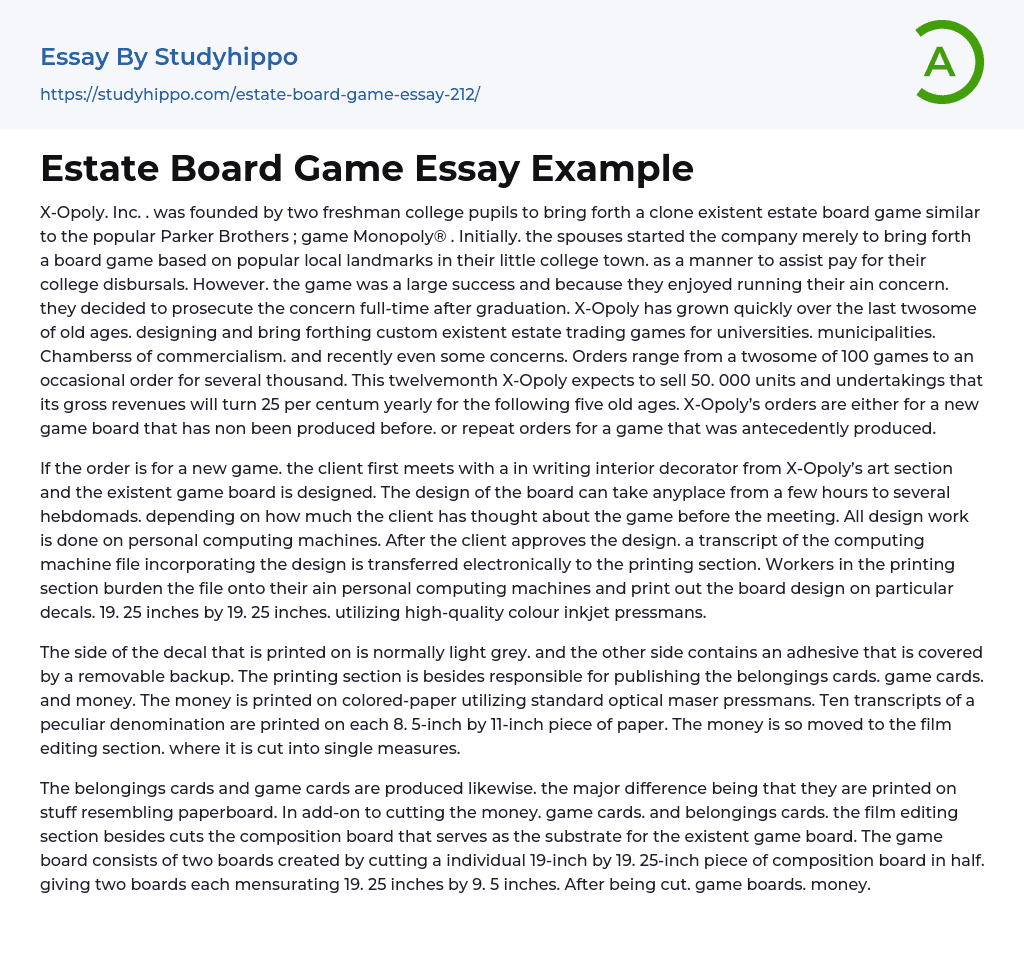X-Opoly.Inc. was founded by two college freshmen with a goal to create a real estate board game similar to Monopoly® by Parker Brothers. The company began as a means to generate revenue for their college expenses, creating a board game based on significant landmarks in their small college community. Post-graduation, they pursued the business full-time due to its success and their passion for entrepreneurship. X-Opoly has grown rapidly over the past few years producing custom real estate trading games for various organizations, ranging from universities to businesses with orders ranging from hundreds to thousands of units. This year alone they expect to sell 50,000 units with projected annual sales growth of 25% for five years. Orders can be either new or repeat orders of previously produced game boards where customers collaborate with graphic designers f
...rom X-Opoly's art department using personal computers until the design is approved and electronically transferred for printing.At X-Opoly, workers utilize their personal computers to load the board design file and print it on special 19.25 inches by 19.25 inches decals using high-quality color inkjet printers. These decals have an adhesive covered by a removable backing on one side and are usually light grey on the printed side. The printing section is also responsible for printing game cards, property cards, and money which is printed on colored paper using standard laser printers with ten copies of each denomination on an 8.5-inch by 11-inch sheet of paper. The money is then sent to the cutting section where it is cut into individual bills along with the property and game cards produced on material resembling paperboard that are also cut in this section. I
addition, this section cuts the composition board used as substrate for the actual game board consisting of two boards created from a single 19-inch by 19.25-inch piece of composition board cut in half to form two boards measuring 19.25 inches by 9.5 inches once cut.
The game boards, money, and cards are then ready for further processing while being kept in carryalls within a work-in-process country before being transported to relevant stations along the assembly line when needed.X-Opoly’s assembly line has evolved into a total of nineteen stations as detailed within a table below.The cycle time of this nineteen-station line and its efficiency remain unknown at present times.
Inquiring about the capacity per day for an 8-hour shift with two 15-minute breaks and its annual capacity assuming X-Opoly is open for 200 days a year. How does this compare to projected demand? Develop a priority graph based on project descriptions for assembly tasks conducted in 19 stations, recommending rebalancing of the line to improve performance using priority relationships. Determine the impact on line efficiency and capacity if recommendations are implemented.
- Gambling essays
- Games essays
- Absolutism essays
- Appeal essays
- Bourgeoisie essays
- Contras essays
- Corporate Governance essays
- Corruption essays
- Democracy essays
- Democratic Party essays
- Developed Country essays
- Dictatorship essays
- Elections essays
- European Union essays
- Federalism essays
- Foreign essays
- Foreign policy essays
- Gentrification essays
- Hillary Clinton essays
- Income Tax essays
- International Relations essays
- John Marshall essays
- John Stuart Mill essays
- Left-Wing Politics essays
- Liberty essays
- Military essays
- Monarch essays
- Monarchy essays
- Political Corruption essays
- Political Party essays
- Political Science essays
- President Of The United States essays
- Public Service essays
- Red Cross essays
- Reform essays
- Republic essays
- Revenge essays
- Social Security essays
- Sovereign State essays
- State essays
- Supply essays
- Terrorism essays
- United Nations essays
- World Trade Organization essays




